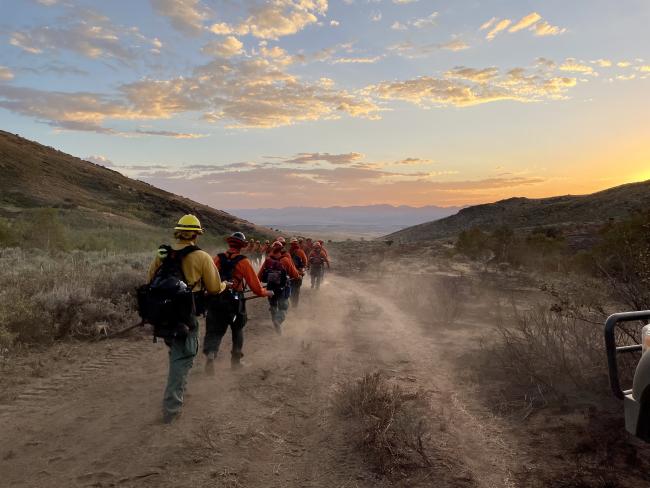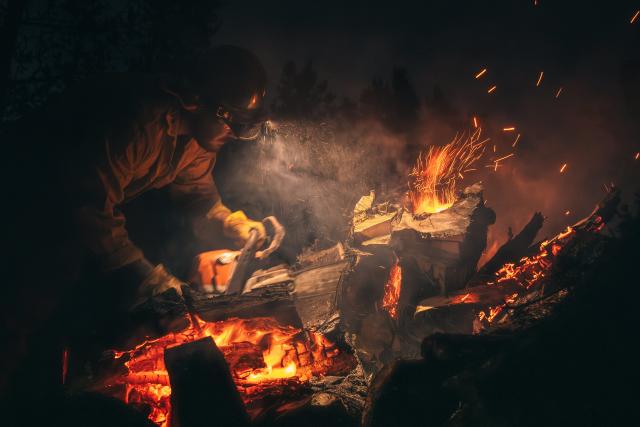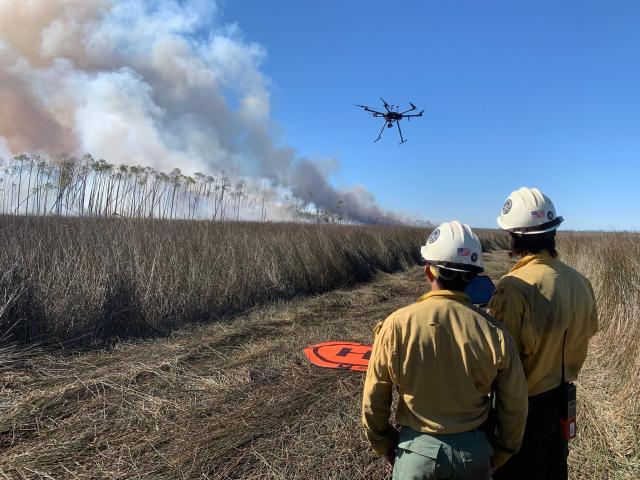BLM Recognizes National Wildfire Awareness Month (Part 3 of 3)
Listen
Subscribe
Related Content
In the final installment of BLM On the Ground’s three-part Wildfire Awareness Month podcast series, we discuss wildfire prevention education, the prevalence of human-caused wildfires, and the importance of public responsibility, such as preparing properly before recreating on public lands, checking fire danger levels, and reporting wildfires immediately.
Transcript
NARRATOR [Mitchell C. Leverette, Public Affairs Specialist]: Welcome back to On the Ground, a Bureau of Land Management podcast. I’m Mitchell Leverette, and this week we’re presenting the final part of our conversation with Nick Howell, Eric Solomon, and Piper Brandt, some BLM employees who work to prevent and fight wildfires. Nick works in investigations, fire prevention, and education out in Utah, while Eric is a fire prevention and mitigation specialist in California. Piper is a public affairs specialist at the National Interagency Fire Center, or NIFC, in Boise, Idaho.
In part one, we talked about the different ways the BLM Fire program prepares for fire season, and part two focused on the importance of good communications. For the final part of the series, Nick, Eric, and Piper will tell us about efforts to educate the public about fire prevention.
LEVERETTE: So, I'm going to go ahead and shift into the final portion of the episode. The portion that's primarily dedicated to both educating the listener on the severity and frequency of fires through stats and numbers from NIFC, as well as leaving the listener with various fire prevention tips, tricks and pointers that they can implement as they make their own plans to go recreate on public lands. Now, in the past two decades, over 50% of the wildfire acreage burned in the continental US was on shrublands and grasslands. Now, for you firefighters, Nick and Eric, does this land description match up with some of the areas that you guys tend to most often?
NICK HOWELL: Yes, I think this description of the shrublands and grasslands definitely applies to my two districts. We have some pretty diverse landscapes where I work here in Utah. We have a little bit of Eastern Great Basin, a little bit of Colorado Plateau, and a fair amount of Mojave Desert. So, we manage just over seven million acres in my two districts that I work with, so there's definitely a representative of my districts.
ERIC SOLOMON: I definitely agree with that as well. Working in the high desert here, working on the California Desert District, definitely some of the areas that we primarily work in and more of our areas that are occupied by folks recreating and using public lands are some of those lighter, flashier fuels and grasses, and a lot of it, we have several large highways that run through our area as well that connect with the Bureau of Land Management areas that we fight fire on. So, that creates definitely some challenges with us, especially when we have a lot of grass growing and those grass fields are continuous causes a bit of a problem for us both on the suppression side and on the prevention side so that’s why we try to have as many folks out in our area talking to folks as possible to try to mitigate that risk and use fuels treatments to try to manage that hazard and that risk.
LEVERETTE: Of course. What do you guys think are some of the leading causes for the human caused fires? What are the sparks for those? You guys were talking about cigarette butts being thrown out, lighters, cars being parked, what are some of the top causes for those human-caused fires?
HOWELL: Yeah, that's a great question, Chase. In my two districts here, well, Utah in general, one of the primary causes of unwanted human caused fires is vehicles traveling along travel corridors. So, when I have conversations with people regarding proper vehicle maintenance, a lot of people don't understand what that looks like. So, yeah, we do have a lot of fires started by people dragging chains on trailers, blown tires just not replacing their tires, you know, after they get worn out, those steel belts go off into the grass and spark a fire. I also have a fair amount of exhaust-related fires. To, you know, those are usually caused by poorly maintained or poorly working exhaust systems on vehicles, and then on years when we have a lot of grass in the lower elevations, we usually have three or four target shooting-related fires as well. So, raising the public awareness that “Hey, this is possible,” this is typically what we see day in and day out that contributes to our you, know average four hundred wildfire year statistics. You know, I think I think it really drives the point home that it does happen, It happens frequently, and there are things we can do to prevent those fires from taking place.
ERIC SOLOMON: In my district definitely shares all those as well. The big travel corridors are such is such a challenge for us to try to prevent fires in those areas. And then for us, we have a huge off highway vehicle. The area out here it's, during the winter months especially, it's incredibly popular. We can get upwards of 100,000 people and some of our largest populated recreation areas, especially on some of the larger holiday weekends, and with that much mechanical equipment out, it definitely puts us on edge and gets us out talking to folks and trying to teach folks how to be careful with that. And the dragging of trailer chains is something that we've definitely struggled with for a long time and actually, just a couple of days ago driving to work, I saw a trailer that was dragging chains and throwing sparks, and it was kind of amazing just how many sparks one chain can throw when it's at freeway speeds being dragged behind a trailer. But luckily, that person was stopped by law enforcement, and I'm sure they let those folks know what was happening and mitigated that. So, that's that partnership that we share and I think everyone was on the lookout for that and with fire prevention being everybody's business, I'm grateful that we have other agencies that that help us out with that.
LEVERETTE: OK. Yeah, because I was going to eventually step into the realm of just maybe asking have you guys ever thought about using law enforcement as a way to get rid of these methods that can obviously start fires like the chains or just, you know, littering, people throwing their cigarette butts out the window when they're driving, things like that. But it looks like you guys are already on top of that which is great. So, I do have some additional stats: roughly between 85%-90% of wildfires are human caused. According to some NIFC stats, there was a fourteen 14% in the number of human-caused fires from the 2023 fire season to the 2024 fire season. There was a 203% increase in the amount of burned acreage between the 2023 and 2024 fire seasons as well. Now, as it's clear that wildfires can affect anybody at any time, what are some key fire awareness, fire prevention rules of thumb that you hope listeners take away from this episode today?
HOWELL: Yeah, what I'm seeing in Utah is our bigger fire seasons are directly correlated with weather and long-term drought conditions. So, it's kind of one of those things before you decide you're going to go out and recreate. Number one would be to have a good, solid plan. Make sure that preparedness is part of that plan. You know, a big part of preventing fires is the basic things like checking the weather conditions. “What are the winds?” and “Am I doing this activity in a location that is appropriate or higher risk for fire danger versus going down the road a few miles to maybe a lower fire danger condition area?” that might help prevent fires. But yeah, the biggest thing is, you know, recreate responsibly, make sure you're prepared before recreating outdoors. Take things like fire extinguishers, shovels, you know, have a basic plan and have fire prevention be a part of that plan. I would say that very much applies to Utah 's situation.
SOLOMON: I absolutely agree with that, and I think part of that education component is just helping folks that may not think about preparing for the worst to put that kind of in their own kind of personal, maybe, risk analysis or kind of a size up as to what they're doing and to understand that, in case something happens, that being prepared and trying to minimize that damage is the best thing that folks can do. So, again, it's such a privilege to protect public lands like that, and I think that folks that are in wildfire prevention really are amazing folks and I love all the folks that I work with and I couldn't be more proud of the work that that we're putting in and although the stats vary year-to-year, and there's so many variables, I think that our education is working and we're still out talking to the public and we're out in communities and we're participating in these education events and places where we can talk about that, and I think that that has really helped us to reduce our human-caused fires.
PIPER BRANDT: Yeah. I think Eric and Nick nailed it. The only thing that I can think of to add, and it's not a direct wildfire prevention tactic, but when there is an act of wildfire, please help out our firefighters by not flying your own drones near active fires. Because if you fly, we can't. It makes things unsafe for our aviation folks. So, that's a big way that you can help us fight fire.
LEVERETTE: For sure. Yeah, I agree. What is the first thing that someone who happens to get caught near a wildfire, what's the first thing they should do? Like, they turn around, they see a wildfire, what's the first thing they got to do?
SOLOMON: Well, the first thing that they need to do is think about their own safety and retreat to a location that is safe, and, once they do that, to definitely report it and have all the information necessary for fire and response units to find the fire and to safely extinguish that. But definitely, really, personal safety is always going to be number one for us.
HOWELL: Yeah. And I really like what Eric said about reporting the fire. This last year, we saw a few incidents. There were people in the public, multiple people in the public, that saw a wildfire start, but they were all assuming that somebody else had already called 911 and reported it. So, I guess the take home message is don't assume it's already been reported. Call it in, call 911 as fast as you can, and we can get firefighters there much quicker when we know about it.
LEVERETTE: OK, awesome. Yeah, do any of you have any programs, websites, other content to plug before we close? You guys have any links or any places that you encourage listeners to check out to get more knowledge about wildfires?
HOWELL: Yeah, absolutely. For Utah, you can check us out on our website, which is utahfireinfo.gov, and we're also on X, formerly known as Twitter, @UtahWildfire. And we're also on Facebook at Utah Fire Info. Thanks.
SOLOMON: I always remind folks to use the BLM social media and BLM California Fire and the BLM California page. A lot of times they'll link back and forth on those if there's information to put out about particular fires.
BRANDT: Yeah, it's always great to follow social media channels that are that are closer to where you are, and, as always, I totally recommend following BLM Fire on Instagram, X, and Facebook, and visiting nifc.gov. We have a lot of resources on the latest national fire news, current and past stats, fire prevention info, and you can find the Wildfire Matters Podcast on there as well.
LEVERETTE: Special thanks to Piper Brandt, Nick Howell, and Eric Solomon for taking the time to get together and provide fantastic insight on the various levels of wildfire management and general fire safety. Links to additional wildfire content such as safety tips, statistics, or anything else in between will be posted on our website. Thanks for tuning in. Once again, this is Mitchell Leverette, and we'll see you out there, on the ground.




